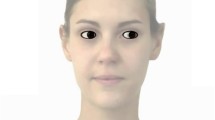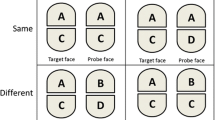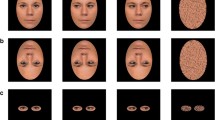Abstract
When faces are turned upside-down they are much more difficult to recognize than other objects. This “face inversion effect” has often been explained in terms of configural processing, which is impaired when faces are rotated away from the upright. Here we report a “gaze inversion effect” and discuss whether it is related to configural face processing of the whole face. Observers reported the gaze locations of photographed upright or inverted faces. When whole faces were presented, we found an inversion effect both for constant errors and observer sensitivity. These results were closely replicated when only the eyes were visible. Together, our findings suggest that gaze processing is largely based on component-based information from the eye region. Processing this information is orientation-sensitive and does not seem to rely on configural processing of the whole face.




Similar content being viewed by others
Notes
Constant errors: Vertical direction×group: F (2,15)=2.484, P=0.117, horizontal direction×group: F (2,15)=0.506, P=0.613, orientation×group: F (2,15)=.219, P=0.806, vertical direction×horizontal direction×group: F (2,15)=0.568, P=0.579, vertical direction×orientation×group: F (2,15)=0.291, P=0.752, horizontal direction×orientation×group: F (2,15)=0.468, P=0.635, vertical direction×horizontal direction×orientation×group: F (2,15)=0.089, P=0.916.
Standard deviations: Vertical direction×group: F (2,15)=0.698, P=0.513, horizontal direction×group: F (2,15)=0.987, P=0.396, orientation×group: F (2,15)=0.721, P=0.502, vertical direction×horizontal direction×group: F (2,15)=0.692, P=0.516, vertical direction×orientation×group: F (2,15)=0.335, P=0.721, horizontal direction×orientation×group: F (2,15)=0.985, P=0.396, vertical direction×horizontal direction×orientation×group: F (2,15)=0.451, P=0.645.
References
Ando S (2002). Luminance-induced shift in the apparent direction of gaze. Perception 31(6):657–674
Anstis SM, Mayhew JW, Morley T (1969) The perception of where a face or television ‘portrait’ is looking. Am J Psychol 82:474–489
Baron-Cohen S (1995a) Mindblindness: an essay on autism and theory of mind. The MIT Press, Cambridge MA
Baron-Cohen S (1995b) The eye direction detector (EDD) and the shared attention mechanism (SAM): two cases for evolutionary psychology. In: Moore C, Dunham PJ (eds) Joint attention: its origins and role in development. Erlbaum, Hillsdale NJ, pp 41–59
Bruce V (1988) Recognising faces. Lawrence Erlbaum Associates, Hillsdale NJ USA
Carey S, Diamond R (1977) From piecemeal to configurational representation of faces. Science 195:312–314
Cline MG (1967) The perception of where a person is looking. Am J Psychol 80:41–50
Diamond R, Carey S (1986) Why faces are and are not special: an effect of expertise. J Exp Psychol: Gen 115:107–117
Farah MJ, Tanaka JW, Drain HM (1995) What causes the face inversion effect? J Exp Psychol: Hum Percep Perform 21:628–634
Gale C, Monk AF (2000) Where am I looking? The accuracy of video-mediated gaze awareness. Percept Psychophys 62(3):586–595
Gibson JJ, Pick AD (1962) Perception of another person’s looking behavior. Am J Psychol 76:86–94
Hasselmo ME, Rolls ET, Baylis CG (1989) The role of expression and identity in the face-selective responses of neurons in the temporal visual cortex of the monkey. Exp Brain Res 32:203–218
Haxby JV, Hoffman EA, Gobbini MI (2000) The distributed human neural system for face perception. Trends Cogn Sci 4:223–233
Haxby JV, Hoffman EA, Gobbini MI (2002) Human neural systems for face recognition and social communication. Biol Psychiatry 51:59–67
Jenkins J, Langton SRH (2003) Configural processing in the perception of eye-gaze direction. Perception 32:1181–1188
Kobayashi H, Kohshima S (1997) Unique morphology of the human eye. Nature 387:767–768
Kobayashi H, Kohshima S (2001a) Evolution of the human eye as a device for communication. In: Matsuzawa T (ed) Primate origins of human cognition and behavior. Springer, Tokyo, pp 383–401
Kobayashi H, Kohshima S (2001b) Unique morphology of the human eye and its adaptive meaning: comparative studies on external morphology of the primate eye. J Hum Evol 40:419–435
Langton SRH, Watt RJ, Bruce V (2000) Do the eyes have it? Cues to the direction of social attention. Trends Cogn Sci 4(2):50–59
Leder H, Bruce V (2000) When inverted faces are recognized: the role of configural information in face recognition. Q J Exp Psychol 53A:513–536
Leder H, Candrian G, Huber O, Bruce V (2001) Configural features in the context of upright and inverted faces. Perception 30:73–83
Lee K, Eskritt M, Symons LA, Muir D (1998) Children’s use of triadic eye gaze information for “mind reading”. Dev Psychol 34(3):525–539
Masame K (1990) Perception of where a person is looking: overestimation and underestimation of gaze direction. Tohoku Psychologica Folia 49:33–41
Maurer D, Le Grand R, Mondloch CJ (2002) The many faces of configural processing. Trends Cogn Sci 6(6):255–260
Nachson I, Shechory M (2002) Effect of inversion on the recognition of external and internal facial features. Acta Psychologica 109:227–238
Perret DI, Hietanen JK, Oram MW, Benson PJ (1992) Organization and functions of cells in the macaque temporal cortex. Phil Trans R Soc Lond B 335:23–50
Rakover S (2002) Featural versus configurational information in faces: a conceptual and empirical analysis. Br J Psychol 93:1–30
Schwaninger A, Carbon CC, Leder H (2003a) Expert face processing: Specialization and constraints. In: Schwarzer G, Leder H (eds) Development of face processing. Hogrefe, Göttingen, pp 81–97
Schwaninger A, Hofer F, Ryf S (2003b) Configural information is processed differently in perception and recognition of faces. Vis Res 43:1501–1505
Searcy JH, Bartlett JC (1996) Inversion and processing of component and spatial-relational information of faces. J Exp Psychol: Hum Percept Perform 22:904–915
Sergent J (1984) An investigation into component and configurational processes underlying face recognition. Br J Psychol 75:221–242
Symons L, Lee K, Cedrone CC, Nishimura M (2004) What are you looking at? Acuity for triadic eye gaze. J Gen Psychol 131:451–69
Tanaka JW, Farah MJ (1993) Parts and wholes in face recognition. Q J Exp Psychol A 46(2):225–245
Valentine T (1988) Upside-down faces: a review of the effects of inversion upon face recognition. Br J Psychol 79:471–491
Yin RK (1969) Looking at upside-down faces. J Exp Psychol 81:141–145
Acknowledgements
This study was supported by a grant to AS from the European Commission (CogVis, IST-2000-29375) and by a grant from the British Academy (LRG 31696) to MHF. JSL was partly supported by a grant from the Swiss National Science Foundation (Project No. 611-066052).
Author information
Authors and Affiliations
Corresponding author
Rights and permissions
About this article
Cite this article
Schwaninger, A., Lobmaier, J.S. & Fischer, M.H. The inversion effect on gaze perception reflects processing of component information. Exp Brain Res 167, 49–55 (2005). https://doi.org/10.1007/s00221-005-2367-x
Received:
Accepted:
Published:
Issue Date:
DOI: https://doi.org/10.1007/s00221-005-2367-x




